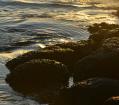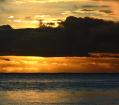Mauritius along with the other Mascarene islands have emerged as a result of gigantic underwater volcanic eruptions to the East of the African and Malagasy continental plate. It is estimated that Mauritius itself started to emerge 8 million years ago, and Reunion island 5 million years later, while Rodrigues – thought to be the most recent – some 1.5 million years ago. Mauritius is encircled by a broken ring of mountain ranges, varying in height from 300–800 m (1,000–2,600 ft) above sea level. These ranges form a ring, suggesting that they are the remnants of the ridges of the extant volcano’s main crater in addition to the isolated peaks and craters found around the island.
Over its millions of years of formation, Mauritius was colonized by plants and animals from Madagascar, Africa, India and Asia through air, wind and sea. The topography created by the volcano has determined pluviometry and soil types in different geographical areas, types of plants and hence different forest structures. The isolation of the island has led to the evolution of these plants and animals into forms distinct from their ancestors, leading to a high level of endemism. Out of 685 native species known to exist in Mauritius, 267 are endemic to Mauritius and another 150 are endemic to the Mascarene islands. Unfortunately, four hundred years of deforestation, agriculture, overexploitation and introduced plants and animals have led to devastating effects on the native forests, such that only 2% remains.
Volcanic islands located in tropical zones are also a prime location for the settlement of corals, which over millions of years have created fringing reefs all around the island and have in turn created a unique coastal and marine ecosystem, with 1700 marine species recorded up to now. Because of the connectivity of oceans, the marine species that have settled around the island are for the most part species that can be found throughout the Indo- Pacific region. The lagoon and its critters have also suffered from coastal development, overfishing and now the already vulnerable corals and associated marine life face the challenges associated with climate change, most notably acidifying oceans and rising sea temperatures
Protecting the remaining native forests, engaging in reforestation activities, and managing coastal and marine resources responsibly will ensure that these ecosystems continue to thrive and to provide vital ecosystem services which human populations and biodiversity rely on. In Bel Ombre, numerous programmes that focus on conservation and protection of terrestrial and marine ecosystems and species have been initiated in collaboration with national organisations including; the Mauritius Wildlife Foundation and Reef Conservation.
Integrated and connected ecosystems
The unique biodiversity of the island rests on a delicate balance of all components of its ecosystems. Despite appearing to be separate realms, terrestrial and coastal/marine habitats are intrinsically connected by water systems, which flow from upland down into the lagoon. Healthy forests retain water, sediments and nutrients, which otherwise would flow to the lagoon, where corals generally thrive in sediment free and nutrient-poor waters. Healthy forests also help support healthy rivers and estuaries, which provide food, shelter, breeding and nursery areas for many juvenile and adult marine species.
In island ecosystems, terrestrial to marine connections are even more relevant. The concept of ‘Ridge to Reef’ management of ecosystems prescribes to an integrated approach to managing multi sector activities within a complete ‘catchment’ or ‘watershed’ from the top of the ridge down to the lagoon and ocean. Hence, ensuring the sustainability of resources, biodiversity conservation, risk reduction and the preservation and generation of livelihoods.












